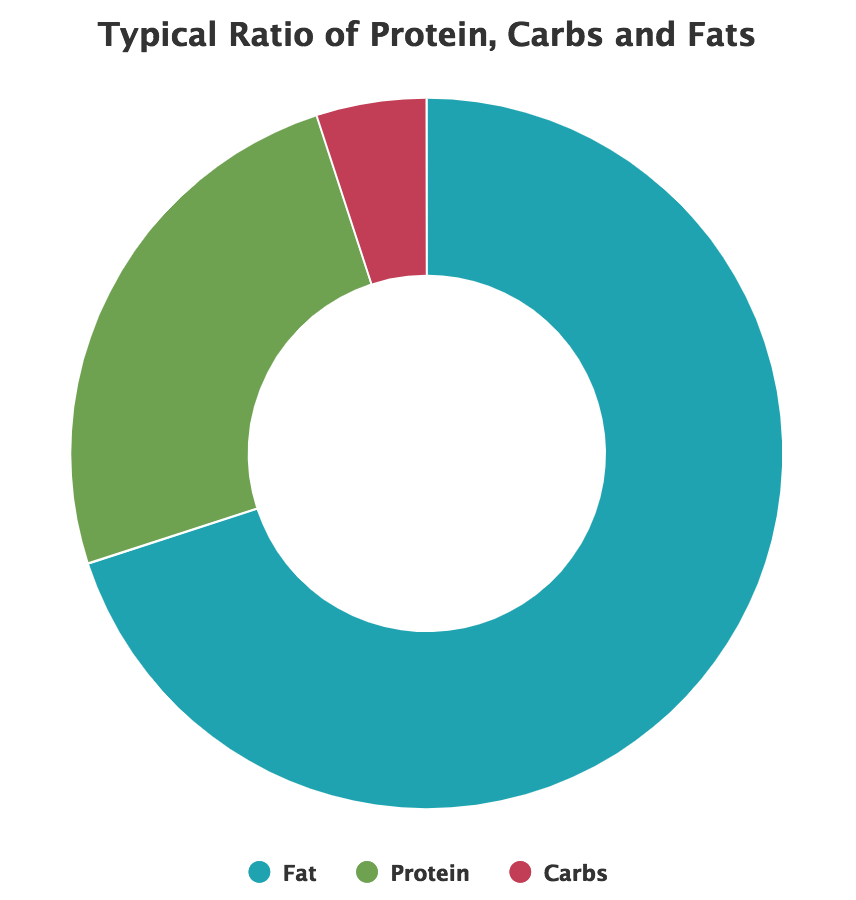Table of Contents
What is the keto diet?
The keto diet, also known as the ketogenic diet, is a low-carb, high-fat and moderate-protein diet. The goal of the keto diet is to shift in to a nutritional state called ketosis – where your body changes from using carbohydrates to fat to fuel weight loss.
How does keto work?
The ketogenic (keto) diet works by starving the body of carbohydrates. When only fat is available, your liver uses fat as an alternative fuel and turns fatty acids in to ketones. These ketones are then used by your body and brain for clean, effective energy that keeps you full – without slowing you down.
From your brain to your blood cells, glucose is typically the most readily available source of energy. We get glucose from the foods that we eat – whether that’s breads and refined sugars or those found naturally in nature, like fructose from fruits. But to keep the body and brain functioning in times of starvation when carbohydrates weren’t available, the human body can adapt to using ketones, instead of carbs for fuel. While the shift from using glucose to ketones might seem unnatural, your brain actually processes ketones more efficiently than glucose. Your brain is like a luxury car – why put in economy fuel if you can afford premium?
But don’t just take our word for it. The keto diet was originally created to treat epilepsy in children, and is still used today in treatment for children and adults with drug-resistant forms of epilepsy.
Ketosis: when your liver converts fats in to fatty acids and ketones
Does the ketogenic diet work?
According to the NIH, there is, “no doubt that there is strong supportive evidence that the use of ketogenic diets in weight loss therapy is effective.” In fact they agree that there are many other positive benefits too, like improved mood and protection from cognitive impairment caused by obesity. For some the keto diet can be easier to maintain than other diets because you get to eat delicious foods like nuts, avocados and cheese, while still feeling full. Unlike many other diets that are hard to upkeep socially, keto also allows for moderate consumption of wine and other alcohol. The keto diet is a great way to look, and feel great.
What do you eat on the keto diet?
With keto you should aim to have 70% of your calories come from fats, 25% from protein and 5% or less from carbs. This means you’ll need to exclude sweet or starchy foods from your diet – not just sweets but also grains, potatoes and high-carb fruits like grapes or bananas.

Foods to eat on keto
With keto you should get the majority of your calories from fat and some protein. This means eating high-fat proteins and choosing low-carb vegetables like cauliflower. Here are just some of the delicious foods you can enjoy with keto:
- Olive oil or Coconut (MCT) oil
- Avocados
- Salad
- Low-carb nuts or nut butters like walnuts, macadamia nuts or pecans
- Zucchini or other low-carb squash
- Broccoli or cauliflower
- Meat and poultry like beef, chicken or lamb
- Berries – strawberries, raspberries
- Cheeses – all kinds! Hard, soft, cottage, they’re all good
- Seafood
Foods to avoid on keto
If you’re trying out the keto diet you should take care to avoid sugary, starchy foods. Remember- carbohydrates should make up less than 5% of your entire calorie intake. Aim to have an absolute maximum of 50 grams of net carbs a day, but aim for 20 grams or less. You can get in ketosis faster by avoiding the following:
- Cakes, cookies and other refined sugars
- Breads and pastas
- High carb fruits like grapes, bananas and apples
- Bananas
Example Ketogenic Foods and Meals |
|
|---|---|
| Breakfast | Avocado with eggs Bulletproof coffee (coffee mixed with butter and MCT oil) Scrambled eggs with cheese |
| Lunch | Salad with protein Zucchini noodle “pasta” Lettuce wrap tacos |
| Snacks | Cold cuts like prosciutto or salami Mozerella sticks Handful of low-carb nuts like almonds, pecans or walnuts |
| Dinner | Steak with broccoli Cobb salad |
| Drinks | Coffee (black or with creamer) Water (sparkling or still) Tea |
Are there any ketogenic diet side effects?
Short term effects of keto are often linked to keto flu
Immediately after starting the diet during the first week, some dieters may experience what is referred to as the “keto flu“. The keto flu is a term colloquially used to describe the general feelings of malaise some dieters feel at the beginning of the low-carb high-fat diet.
While not all dieters experience keto flu, some symptoms can include:
- flu-like symptoms like weakness or muscle soreness
- intense sugar cravings and withdrawal
- changes to bowel movements like constipation or diarrhea
- irritability
- lowered libido
- muscle cramps or charley horses
- poor concentration
Keto flu can be prevented or helped by focusing on getting plenty of sleep, increasing electrolyte intake, and reducing consumption of dehydrating drinks like caffeine and alcohol.
But fear not! Starting out with keto has some positive benefits, too.
During the initial adjustment phase most dieters report rapid weight loss – losing up to 10 lbs of body weight in 2 weeks or less. After the adjustment period weight loss will be slower and normalize.
Long term effects of keto
While extensive studies of keto don’t exist, avid fans of keto and other low-carb diets effuse keto’s praise for improving not only their waistlines, but their overall health and well-being too. Some positive benefits of keto include:
- improved energy levels
- deeper, more restful sleep
- improved mental clarity and focus
- better mood
- reversal of diabetes in some patients
Is keto like other low-carb diets?
Yes and no. While low-carb diets aren’t new, keto has a different macronutrient profile than other low-carb diets like Atkins. Most keto dieters start off with a diet where 70% or more of the calories come from fat– and carb intake is limited to just 5% of calories or less. The old Atkins plan allowed for up to 10% of calories to be consumed from carbs, and encourages higher levels of proteins than fat.
Keto vs. Other Low-Carb Diets
| Low-Carb Diet | Fat | Protein | Carbs |
|---|---|---|---|
| Keto Diet | 70% | 25% | 5% |
| Atkins Diet | 50% | 40% | 10% |
| Low-Carb | 30-40% | 40% | 20-30% |
How can I start the keto diet?
Getting started with keto doesn’t have to be scary! With these three easy steps, you can be on your way to losing fat fast and feeling great.
Step 1: Clean out your fridge and pantry
Like with most diets, it can be easy to slip back in to old ways. Get rid of foods that might tempt you to make it easier to resist initial sugar cravings that might come.
Step 2: Stock up on keto-friendly foods and snacks
Head to your local grocery store to stock up on these good-for-you keto foods and groceries.
Step 3: Track your ketone production for the best results
To gauge how deep you are in ketosis, you can measure the amount of ketones your body is producing. Even if you think you’re sticking to your diet, sugar can hide in salad dressings, condiments, restaurant food and sauces, so it’s best to monitor how you’re doing every day. Some popular methods of tracking ketosis include:
- Ketone pee strips
- Blood tests and monitors
- The Keyto – our ketone breath analyzer. It’s painless and reusable!
More than 10,000 Keytos have already been purchased. Get yours here.
FAQ
How many carbs should I have on a keto diet?
Someone following a keto diet should try to have a maximum of 50 net carbs every day. Try to aim for 20 grams of carbs or less for optimal results.
Do I still need to count calories?
Calories still count on the keto diet. However most dieters report reduced appetite and are able to “feel full” while eating less. Feeing full while eating less? Yup, you read that right.
Are bananas keto friendly?
While bananas are not an “unhealthy” food, their high carbohydrate count (28 net carbs for a small banana!) make them suboptimal for those on a keto diet. If you’re trying out keto and love bananas, consider eating only a small portion of a banana and slicing it very thinly, or substitute bananas for banana-flavored extracts instead.
Can I still have cheat days?
Yes you can! Many people who are “keto-adapted” (have consistently maintained deep ketosis) report being able to stay in ketosis despite having a rare high-carb treat like beer, sushi or cake. But proceed with caution – “cheating” on a regular basis or designating a weekly cheat day is highly discouraged on keto. Due to the high fat concentration of keto foods you can easily regain the weight (or gain more weight) if you’re not actually in ketosis and cheating regularly. Like all diets – the better you adhere to the diet the better (and faster!) your results.
But won’t eating fat make me…fat?
Nope! That’s a common misconception. But don’t just take our word for it. According to the NIH, “the popular belief that high-fat diets cause obesity and several other diseases such as coronary heart disease, diabetes, and cancer has not been observed in recent epidemiological studies.”
Is ketosis safe?
There is no literature or long-term evidence that implies keto is not a safe lifestyle or diet. What we do know is that a diet high in sugar is linked to much of the most common and serious health ailments, including: cancers, stroke, diabetes, Alzheimers etc.
But like any diet, be sure to ask your doctor before adopting any new diet or exercise regimen.
